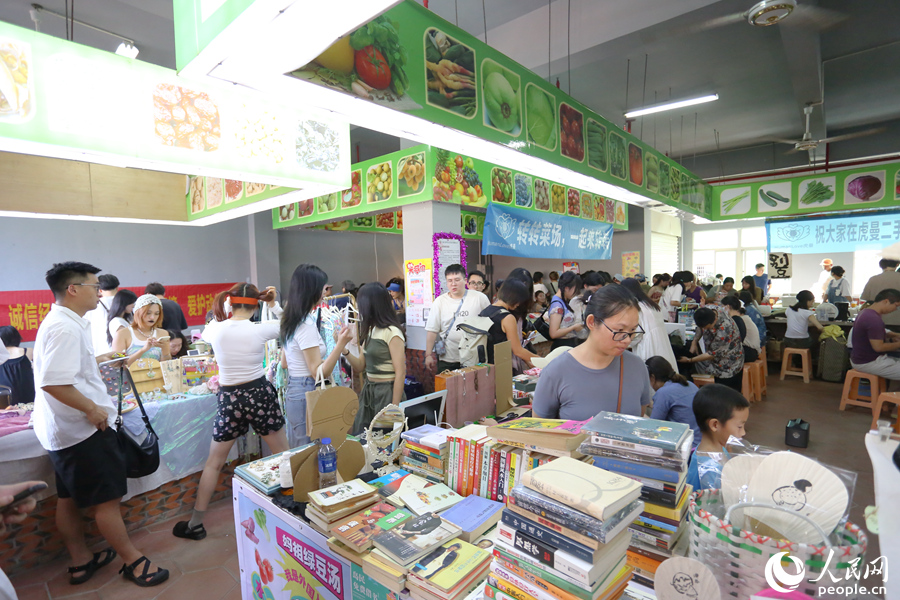China's booming second-hand market fuels circular economy
In recent years, an increasing number of people in China are choosing to sell their used items on second-hand platforms, giving rise to a new lifestyle centered around buying and using pre-owned goods.
A report released by Tsinghua University's Institute of Energy, Environment and Economy and other institutes revealed that China's second-hand market has reached 1 trillion yuan ($138 billion) since 2020 and is projected to exceed 3 trillion yuan by 2025.

People visit a market for used goods in Xiamen, southeast China's Fujian Province. (People's Daily Online/Chen Bo)
The market offers a wide range of items, including household appliances, furniture, skincare products and books.
China's second-hand e-commerce market reached a scale of 480.2 billion yuan in 2022, with a user base of 263 million people, representing a year-on-year growth of 20 percent and 17.9 percent, respectively.
The second-hand market has become a significant sector in the online consumer market, with platforms like Kuaishou and Douyin leveraging the power of livestreaming to drive growth in the industry.
Offline second-hand trading markets are also flourishing. In Hangzhou, east China's Zhejiang Province, the first Xianyu Recycle Shop opened at the end of January 2024, offering both buying and selling services and attracting many customers.
Xianyu, or Idle Fish, is a second-hand mobile marketplace spun from Alibaba's Taobao.
In southwest China's Chongqing Municipality, offline second-hand markets have gained popularity on social media, drawing in many tourists who specifically visit the city to search for vintage clothing and accessories.
China's thriving second-hand economy can be attributed to a change in consumer attitudes, especially among younger generations.
User data from various second-hand e-commerce apps reveals that people aged 18-34 are actively participating in the second-hand economy. Today's youth prioritize practical consumption, valuing goods based on their usefulness rather than their price tag or status symbol.
During the Chengdu Universiade in 2023, many athletes were seen carrying red bags containing second-hand phones borrowed from the Chengdu Universiade Village. These phones were provided for free by Zhuanzhuan, an online trading platform for used goods in China, making the Chengdu Universiade the world's first international sports event to introduce second-hand circular services and contribute to carbon reduction efforts.
According to data, China's mobile phone shipments reached 289 million units in 2023, with a corresponding increase in discarded and unused phones. It is projected that the total number of idle phones during the 2021-2025 period will reach 6 billion units.
Improper handling of these discarded phones can result in wasted valuable components and precious metals, posing a significant pollution risk.
To address this issue, some second-hand platforms are using the internet and data analysis to facilitate the large-scale recycling of discarded phones. This has led to the creation of a strong network of businesses that work together to properly dispose of and recycle various old products.
Liu Rui, director of the Department of Environmental Technology and Ecology, Yangtze Delta Region Institute of Tsinghua University, Zhejiang, said that second-hand transactions are an important part of green consumption. They can extend the lifespan of goods, reduce carbon emissions on the consumer side, and contribute to the green transformation of the economy and society.
"Recycling can effectively reduce carbon emissions from the extraction of raw materials, transportation, and production processes," said Zhu Liyang, president of the China Association of Circular Economy (CACE).
Xianyu users who bought and sold idle items helped reduce carbon emissions by more than 3 million tonnes in the 2023 fiscal year. This reduction was equal to the amount of carbon emissions produced by 2.25 million households' electricity usage in a single year.
The CACE estimates that by 2025, the circular economy will contribute more than 30 percent to China's carbon emission reduction efforts.
Photos
Related Stories
Copyright © 2024 People's Daily Online. All Rights Reserved.









